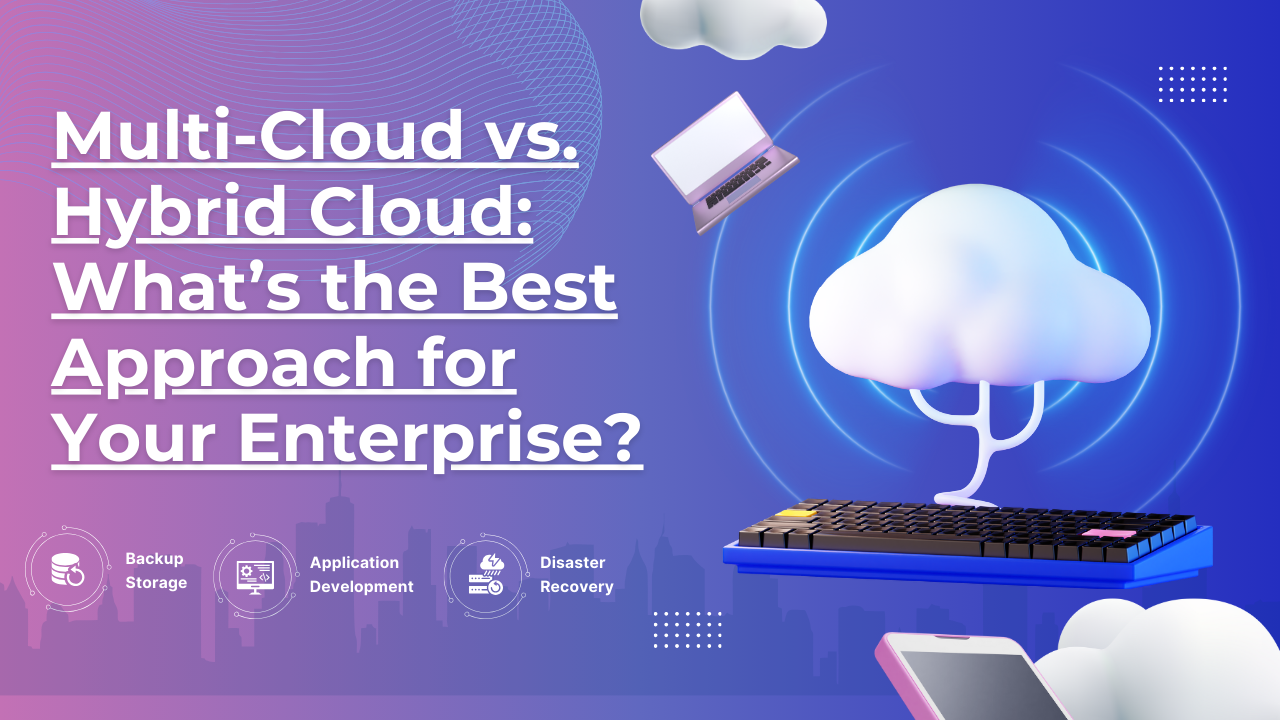In today’s rapidly evolving technological landscape, enterprises are faced with an overwhelming number of choices when it comes to cloud computing. Two of the most discussed strategies are Multi-Cloud and Hybrid Cloud environments. While both approaches aim to enhance flexibility, performance, and efficiency, they serve different business needs and can significantly impact an organization’s IT strategy. In this blog, we’ll delve into the differences between Multi-Cloud and Hybrid Cloud solutions, explore their respective advantages and disadvantages, and help you determine which approach may be best for your enterprise.
Understanding Multi-Cloud and Hybrid Cloud
Multi-Cloud
Multi-Cloud refers to the use of multiple cloud service providers (CSPs) for different services within a single architecture. This strategy allows organizations to utilize various cloud services from different vendors, such as Amazon Web Services (AWS), Microsoft Azure, Google Cloud Platform (GCP), and others, based on specific requirements. For example, an enterprise might use AWS for data storage, Azure for machine learning services, and GCP for analytics.
Advantages of Multi-Cloud
- Avoid Vendor Lock-In: By distributing workloads across multiple providers, organizations can avoid dependency on a single vendor. This can lead to increased bargaining power and flexibility in negotiating contracts.
- Best-of-Breed Solutions: Multi-Cloud allows enterprises to select the best services from each provider. Companies can leverage specific tools and technologies that best fit their needs, leading to improved performance and efficiency.
- Redundancy and Resilience: Using multiple cloud providers can enhance disaster recovery and business continuity. If one provider experiences an outage, businesses can quickly switch to another, ensuring minimal disruption.
- Cost Optimization: Organizations can optimize costs by choosing the most cost-effective services for their needs. This allows for more strategic financial planning.
Hybrid Cloud
Hybrid Cloud, on the other hand, combines on-premises infrastructure (private cloud) with public cloud services. This approach allows organizations to maintain control over sensitive data while leveraging the scalability and flexibility of the public cloud for less sensitive operations. For instance, a company might keep its core applications and sensitive customer data in a private cloud while using a public cloud for backup, disaster recovery, or to handle peak loads.
Advantages of Hybrid Cloud
- Data Security and Compliance: Hybrid Cloud allows organizations to keep sensitive data on-premises or in a private cloud, ensuring compliance with regulations while still taking advantage of public cloud capabilities for other workloads.
- Flexibility and Scalability: Organizations can scale their resources quickly based on demand, utilizing public cloud resources when necessary while maintaining core operations on-premises.
- Cost Management: Companies can optimize their IT budgets by keeping predictable workloads on-premises while leveraging the public cloud for variable workloads, allowing for cost-effective scalability.
- Seamless Integration: Hybrid Cloud architectures often allow for easier integration between existing on-premises systems and cloud services, facilitating smoother data movement and management.
Comparing Multi-Cloud and Hybrid Cloud
| Feature | Multi-Cloud | Hybrid Cloud |
|---|---|---|
| Architecture | Uses multiple public cloud providers | Combines private and public cloud |
| Control | Less control over sensitive data | Greater control over sensitive data |
| Cost Management | Potentially higher costs if not optimized | Cost-effective for predictable workloads |
| Vendor Lock-In | Reduces risk of vendor lock-in | May still rely on one vendor for private cloud services |
| Scalability | High scalability across multiple platforms | High scalability, leveraging both on-premises and cloud resources |
Which Approach Is Best for Your Enterprise?
Choosing between Multi-Cloud and Hybrid Cloud depends on your organization’s specific needs, compliance requirements, and operational objectives.
Consider Multi-Cloud If:
- You want to avoid vendor lock-in and leverage the best services from multiple providers.
- Your workloads are not sensitive, allowing for a more flexible approach to data management.
- You require redundancy and resilience across different cloud environments.
- You want to optimize costs by choosing the most cost-effective services available.
Consider Hybrid Cloud If:
- You deal with sensitive data that must comply with strict regulations, requiring more control over where data is stored.
- Your organization has existing on-premises infrastructure that you want to continue utilizing while also leveraging public cloud services.
- You want to scale resources flexibly, balancing predictable workloads with variable demands.
- You seek seamless integration between existing systems and cloud solutions.
Conclusion
Ultimately, the choice between Multi-Cloud and Hybrid Cloud comes down to your enterprise’s unique requirements and strategic goals. Both approaches offer significant benefits, and many organizations may find that a combination of the two models best serves their needs. By carefully evaluating your specific use cases, compliance requirements, and budget constraints, you can determine the cloud strategy that will empower your organization to thrive in the digital age. As you embark on your cloud journey, remember that flexibility, scalability, and security are paramount in today’s competitive landscape.
